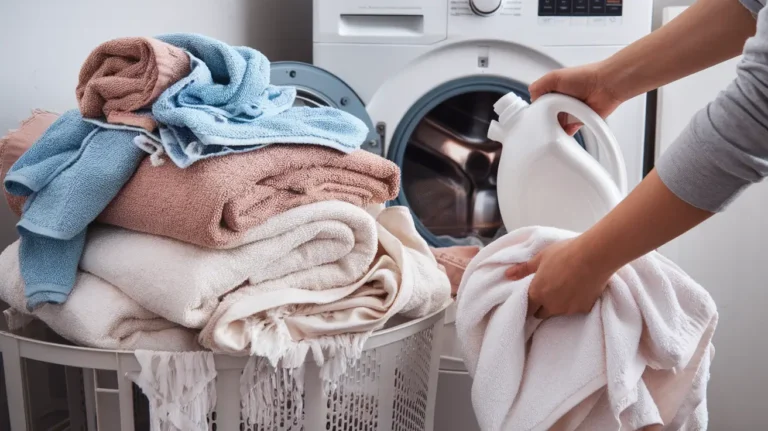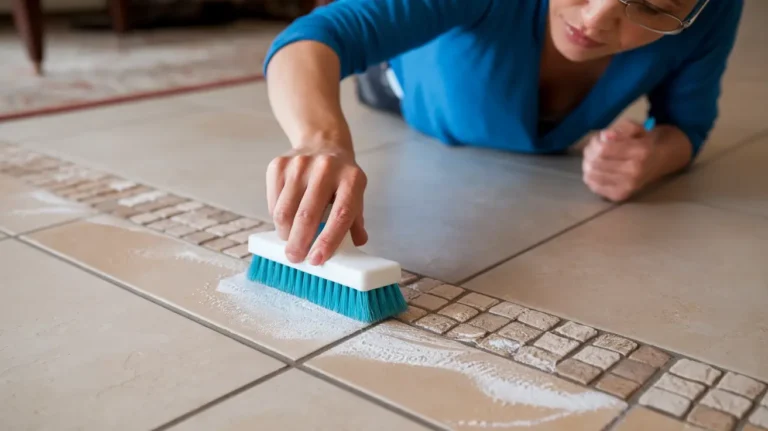How to Clean a Washing Machine: Simple & Effective Tips

Is your freshly washed laundry coming out not-so-fresh? A clean washing machine plays a vital role in your laundry’s cleanliness and scent.
Over time, detergent residue, dirt, and moisture can take a toll on your appliance, leading to unpleasant odors, bacteria build-up, and reduced washing efficiency.
By following this guide, you’ll learn exactly how to clean and maintain your washing machine. Let’s restore that sparkling performance and ensure every load comes out spotless and smelling divine!
Why Do Washing Machines Need Cleaning?
Eliminating Germs and Bacteria
Washing machines are the perfect environment for bacteria and mold. Damp conditions combined with leftover detergent create the ideal breeding ground for harmful microbes.
Regular cleaning keeps bacteria and mold at bay, ensuring your washer stays a safe and clean place for your clothes.
Preventing Dirt and Residue Buildup
Every wash cycle leaves behind traces of dirt, body oils, soap, and fabric fibers. Over time, these layer up, clogging the machine and affecting its ability to clean effectively.
Proper maintenance dissolves these deposits and prevents odors from spreading to your laundry.
Maintaining Machine Performance
A dirty machine loses efficiency. Clogged filters and residue-coated drums can reduce water flow, lengthen cycles, and wear out the motor faster.
Regular cleaning boosts performance and extends your machine’s lifespan.
Gathering Your Cleaning Supplies
Before you begin, gather these essentials to make the cleaning process smooth and effective:
- White vinegar: A natural deodorizer and cleanser that’s great for breaking down dirt, grime, and soap scum.
- Baking soda: Perfect for removing stubborn odors and gently scrubbing away residue without damaging surfaces.
- Commercial washing machine cleaner: Optional, but effective for deep cleans and tackling tough buildup in both front-loading and top-loading washers.
- Tools: A soft cloth or sponge to wipe down surfaces without scratching. An old toothbrush to reach those tricky corners, seals, and crevices that are hard to clean with larger tools. Gloves (optional) to protect your hands from dirt or cleaning agents during the process.
Step-by-Step Guide to Cleaning Your Washing Machine
Maintaining a clean washing machine is essential to ensure your laundry stays fresh and your machine works efficiently.
Over time, detergent residue, grime, and mold can build up, causing odors and affecting performance. Follow these steps to deep clean your washer and keep it in top condition.
Using a Homemade Solution of Vinegar and Baking Soda
Natural, effective, and budget-friendly, this DIY solution is great for regular maintenance.
1. Baking Soda First
Sprinkle about half a cup of baking soda directly into the drum. Baking soda acts as a gentle abrasive to lift grime while neutralizing unpleasant odors. Be sure to evenly distribute it for maximum effectiveness.
2. Add Vinegar
Pour two cups of white vinegar into the detergent dispenser or directly into the drum. Vinegar is a natural cleaning agent that dissolves detergent residue, breaks down mineral buildup, and kills bacteria and mold that may be lurking inside.
3. Run a Hot Wash Cycle
Set your washing machine to its hottest and longest cycle. The combination of vinegar’s acidity and the heat will thoroughly disinfect the drum, eliminate stubborn residue, and remove hidden bacteria.
For extra freshness, pause the cycle midway and let the solution soak for 30 minutes before continuing.
4. Wipe Down the Drum
Once the cycle ends, use a clean cloth to wipe the drum and remove any leftover debris or residue. Don’t forget to inspect the edges and corners of the drum where grime can accumulate.
Using a Commercial Washing Machine Cleaner
If your washing machine has stubborn buildup or has gone a long time without cleaning, consider using a commercial cleaner designed specifically for washing machines. These products are formulated to target tough stains, mineral deposits, and odors.
1. Follow Product Instructions
Always read the instructions on the product label. Most cleaning solutions require you to add the cleaner to an empty drum or the detergent dispenser.
Some may also suggest running a specific cleaning cycle if your machine has one.
2. Run the Cleaning Cycle
Add the recommended amount of cleaner and set your washing machine to a hot cycle. The heat helps activate the cleaner, allowing it to penetrate deep into the internal parts of the machine.
This process effectively removes mineral buildup, trapped detergent, and lingering odors.
Deep Cleaning Specific Parts
Certain parts of your washing machine need special attention to ensure optimal performance. These areas can harbor dirt, mold, or debris that may not be removed during a regular cleaning cycle.
1. Door Gasket (for Front Loaders)
The door gasket is a common spot for mold and mildew to grow because water often gets trapped in the folds of the rubber seal. Pull back the gasket and inspect for trapped water, detergent residue, or debris.
Use a cloth dampened with vinegar to wipe it clean, and use a toothbrush to scrub hard-to-reach areas. Be thorough around the edges to prevent future buildup.
2. Agitator (for Top Loaders)
The agitator in top-loading machines can accumulate grime over time, especially if it’s removable.
Detach the agitator if your machine allows it, and soak it in warm, soapy water for 30 minutes. Scrub it thoroughly with a brush to remove any dirt or residue before reinstalling it.
3. Filters
Many washing machines have filters designed to trap lint, small debris, and other particles. These can become clogged and reduce efficiency if not cleaned regularly.
Check your user manual to locate the filter, remove it, and rinse it thoroughly under running water. Use a soft brush to remove stubborn debris, and let it air dry before putting it back in place.
4. Detergent Tray
Over time, detergent and fabric softener can leave sticky residue behind in the detergent tray, which can lead to clogs.
Remove the tray if possible, and soak it in warm, soapy water for a few minutes.
Use a brush or sponge to scrub away any buildup, rinse thoroughly, and dry before reinserting it into the machine.
Maintenance Tips for a Cleaner Washing Machine
Cleaning your washer once is great, but maintaining it is even better. Incorporate these tips into your routine for lasting results:
- Dry After Each Use: Wipe the drum and door gasket dry after every use. Leave the door slightly ajar to promote airflow and prevent moisture buildup.
- Use the Right Amount of Detergent: Excess detergent creates residue and leads to clogs. Check your washer’s manual to determine the recommended amount.
- Monthly Hot Wash Cycles: Run an empty hot cycle once a month using vinegar or a cleaning tablet to ensure no dirt or bacteria builds up unseen.
- Inspect the Filter Regularly: Lint traps or filters collect debris and need frequent cleaning to ensure your machine runs without blockages.
- Avoid Overloading the Machine: Overfilling your washer stresses components and diminishes cleaning results. Ensure your loads are within the suggested weight limits for optimal performance.
Keep Your Washer Fresh with Continuous Care
A clean washing machine ensures fresh, spotless laundry every time you wash.
Simple monthly maintenance and the detailed steps outlined above prevent odors, bacteria, and buildup from taking over your appliance.
Now it’s your turn to take control. Give your washing machine the care it deserves! By doing so, you’ll not only prolong its life but also enjoy the satisfaction of consistently cleaner clothes.
Plus, it’s just another step in creating a healthier, more efficient home.








